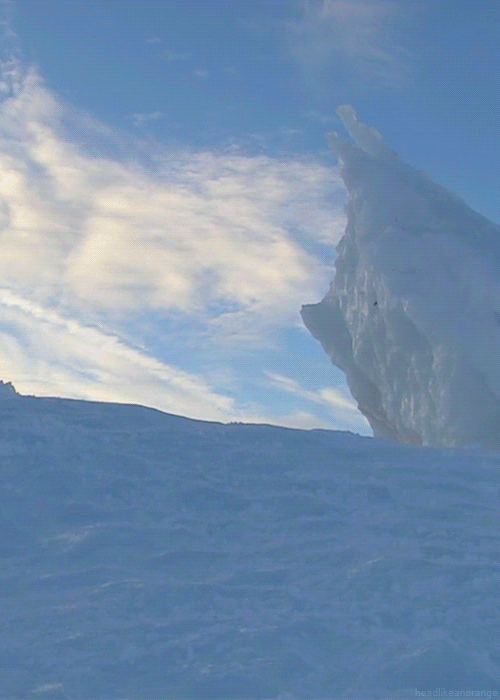
Rafa Spoladore Ψ
Shared posts
kushra: preview of the new pics ill be posting soon :) big...





preview of the new pics ill be posting soon :) big thanks to gotham-city-hardcore for getting me this gorgeous corset
Nasa confirma missão para capturar asteroide... maomenos
Rolaram, nos últimos dias, boatos de que o orçamento da Nasa para o ano fiscal de 2014 traria a previsão de uma missão para rebocar um asteroide para perto da Terra, onde ele poderia ser estudado em detalhes. A informação tinha sido divulgada por um senador da Flórida (Estado onde fica o Centro Espacial Kennedy, e cuja economia levou uma bela traulitada com o fim do programa de ônibus espaciais).
A parte boa é a nota divulgada pelo administrador da agência espacial, Charles Bolden, que diz lá pelo meio: "Estamos desenvolvendo a primeira missão jamais realizada para identificar, capturar e relocar um asteroide". Mais claro impossível, certo? Mas espere o que vem logo adiante: "Usaremos capacidades existentes, como a nova cápsula Orion e o foguete Sistema de Lançamento Espacial (SLS), e desenvolveremos novas tecnologias como a propulsão elétrica solar e comunicações a laser".
Isso deixa uma certa impressão de que a iniciativa para o asteroide não representa uma coisa nova, em si, mas apenas um jeito de aproveitar -- e justificar -- o que já vinham fazendo. Tanto a Orion quanto o SLS são programas vestigiais do velho Projeto Constellation, estabelecido durante a Era Bush para levar astronautas de volta à Lua e que foi impiedosamente cancelado por Obama. E propulsão elétrica solar e comunicação a laser é o tipo de coisa que a Nasa precisa desenvolver de qualquer jeito, para que suas sondas espaciais sejam mais eficientes.
A nota de Bolden também não dá data para a tal captura de asteroide, embora mencione os prazos para a realização de um pouso humano num desses astros (até 2025) e o lançamento do Telescópio Espacial James Webb, sucessor do Hubble (em 2018).
O texto do orçamento propriamente dito -- que pode ser acessado em PDF aqui -- é ainda mais vago. Ele diz que a Nasa "planejará e começará a projetar esta missão em 2013. Progresso continuará dependendo de sua factibilidade e custo". O que traz à mente a imortal frase "famosas últimas palavras".
 Os parâmetros da missão são especificados da seguinte forma: "Identificar, capturar, redirecionar e retirar amostras de um pequeno asteroide". Isso soa menos como a ideia de um potentoso rebocador espacial e mais com uma versão, talvez um pouco mais ambiciosa, do que os japoneses já fizeram em sua missão Hayabusa, que trouxe poeira de astroide para a Terra em 2010.
Os parâmetros da missão são especificados da seguinte forma: "Identificar, capturar, redirecionar e retirar amostras de um pequeno asteroide". Isso soa menos como a ideia de um potentoso rebocador espacial e mais com uma versão, talvez um pouco mais ambiciosa, do que os japoneses já fizeram em sua missão Hayabusa, que trouxe poeira de astroide para a Terra em 2010.Quando a notícia de que uma "captura de asteroide" estava nos planos da agência espacial, os mais otimistas logo se lembraram do relatório Asteroid Retrieval Feasibility Study, do Instituto Keck, publicado há um ano e já clássico. O trabalho apresenta um plano detalhado para a captura de um asteroide de meio milhão de toneladas, que ficaria estacionado em órbita da Lua, onde poderia ser estudado detalhadamente por astronautas. A missão poderia ser executada até 2025, a um custo de US$ 2,6 bilhões.
Levando-se em conta que o orçamento total da Nasa para ciências planetária e da Terra, em 2014, está estimado em cerca de US$ 4,6 bilhões, dá para ver que a proposta saiu meio salgada. E o orçamento divulgado hoje ainda precisa passar pelo Congresso, onde poderá sofrer cortes.
Andrew Wiles: 60th birthday
In 1996, Simon Singh produced this 50-minute documentary for the BBC Horizon series. And I just watched it again and liked it a lot.
Wiles' father was a chaplain in Cambridge – and a professor of divinity at Oxford. The program convinced me – without saying it – that this religious background was important for Wiles to know how to get concentrated for the years that were needed to complete the proof. Note that he first presented a proof in 1993, one that was seen to have a gap, and he was able to fill the gap within 15 months.
Singh's documentary is composed of testimonies of mathematicians. I personally know Barry Mazur – as a kind companion from the Harvard Society of Fellows – and he was clearly a pretty important puppet master behind some key developments although this modest man wouldn't claim credit for that.
Recall that Fermat conjectured, among other things, that\[
x^n+y^n=z^n,\quad \{x,y,z,(n-2)\}\subseteq \NN^+
\] has no solutions. If the exponent were \(n=1\), there would surely be solutions. For example, you may remember from your college that \(1+1=2\). Similarly, there are lots of solutions for \(n=2\); we know them as simple examples of the Pythagorean theorem. For example, \(7^2+24^2=25^2\) if I avoid the two most notorious examples.
But for third powers and higher powers, the identity just can't hold, we know today and people have suspected for centuries. It can't hold for any positive integers. Equivalently (as you may see by multiplying the equation by a common denominator), it can't hold for any positive rational numbers. Most of the famous mathematicians in recent centuries focused on the problem. At most, they achieved partial results, most typically a proof for some value of \(n\).
Note that it's enough to prove the theorem for \(n=4\) – which is particularly simple – and for prime integers \(n\gt 2\). It's because for other numbers factorized as \(n=pq\), one may see that a counterexample with the exponent \(n\) would also imply the existence of counterexamples with the exponents \(p,q\). Those exist for \(n=2\) which is why \(n=2\times 2\) requires a special treatment but otherwise the pattern simplifies things in the most natural way you can think of.
By the early 1990s, the proof had been known for \(n\) up to a very large value. But no general proof existed. In fact, the conjecture was even closer to "fringe maths" in the 1970s when the impatient, industrialized world of state-funded mathematics nearly decided that there couldn't be a proof of the general theorem because the tons of state-funded mathematicians would have already found it.
Well, that was a wrong expectation. The proof existed and was ultimately found by Wiles but it required some modern mathematical techniques that were probably unavailable to Fermat. It seems virtually impossible for Fermat to possess a proof that is nearly equivalent to Wiles': the type of mathematical technology these two men could use differed as much as nuclear reactors differ from steam engines. You just don't expect James Watt to play with similar devices as Robert Oppenheimer.
However, it's somewhat more imaginable – although still insanely sounding - that Fermat had a more elementary proof, one which remains unknown to us. Most likely, Fermat either made a mistake or he deliberately wanted to present himself as a super-genius by a false claim that "he has a wonderful proof that doesn't fit to this small margin". However, he didn't quite fool us because we have rather good reasons to think that Fermat didn't have a proof. ;-)
In the 1970s, the conjecture was returning to mainstream maths because it was realized that Fermat's Last Theorem followed from a modularity theorem ("Taniyama-Shimura"). This theorem says that every elliptic curve – a torus written using complex variables as\[
y^2 = x^3+ax+b
\] and I may publish a crash course in F-theory where I explain these matters in a near future – is a modular curve, one written using the \(j\)-invariant and enjoying lots of special mathematical properties.
These elliptic curves were relevant for the validity of Fermat's Last ex-Conjecture because if there were a counterexample to Fermat's negative claim, you could also construct an associated elliptic curve that isn't modular (weird!), in contradiction with the modularity theorem. These ideas provided the mathematicians with a "sketch" of proofs and the actual proofs were gradually found, by the 1980s. It was firmly proven that the modularity conjecture, if true, implied Fermat's Last Theorem, and the so-called \(\varepsilon\)-theorem was one of the last pieces needed to establish these links.
So the remaining task – one that Wiles solved – was to prove the modularity conjecture for some curves (equations). He did so. The original strategy was to "count and match" the elliptic curves and the modular forms. The minimal implementation of this strategy didn't work so he decided to match the Galois representations instead.
At the general level, the proof of the Riemann Hypothesis will follow the same strategy. A counterexample to the Riemann Hypothesis – a non-trivial root of the zeta-function away from the critical axis – would probably allow you to construct some weird mathematical object that can't exist, either. We may even know what the next step – the rough type of this "weird object" – is. It's probably a weird, non-real eigenvalue of a Hermitian operator or (my strategy) a non-existent representation of \(SL(2,\ZZ)\). Still, we need to know the third step to be closer to a solution.
I've spent hundreds of hours with the Riemann Hypothesis in my life and yes, I repeatedly thought that I essentially had it. ;-)
Will there be a lot of hurricanes in 2013? [Greg Laden's Blog]
Probably.
The Tropical Meteorology Project at Colorado State University makes annual predictions of hurricane season activity, and they released one of these predictions today. This particular group has a good track record, although I would worry that they tenaciously hold to the idea that global warming is not a factor in hurricane development despite the fact that some of the factors (a disrupted ENSO and high SST) that are most affected in the Atlantic by global warming actually drive their predictions. Still, their predictions seem to be based on good empirical data and are probably robust. (Other season forecast information is to be found below).
El Nino conditions tend to reduce hurricane activity, and the warmer the waters in the North Atlantic, the more likely hurricanes are to form from tropical depressions, the stronger they are likely to be, and the longer they are likely to last.
This year, El Nino conditions are unlikely to develop, and sea surface temperatures in the North Atlantic are unusually high as they have been for a few years.
The TMP has released this PDF of their report, which states:
We anticipate that the 2013 Atlantic basin hurricane season will have enhanced activity
compared with the 1981-2010 climatology. The tropical Atlantic has anomalously
warmed over the past several months, and it appears that the chances of an El Niño event
this summer and fall are unlikely. We anticipate an above-average probability for major
hurricanes making landfall along the United States coastline and in the Caribbean.
Coastal residents are reminded that it only takes one hurricane making landfall to make it
an active season for them, and they need to prepare the same for every season, regardless
of how much or how little activity is predicted.
TMP predicts that there is a 72% chance of at least one category 3 or above hurricane landing somewhere on the US coastline (the average probability over the last century is 52%). There is a 48% of such a landfall along the Atlantic coast plus Florida not counting the panhandle (compared to the century average of 31%) and a 47% probability for the Gulf Coast on the Florida Panhandle and points west to Brownsville (compared to 30%). The chance of at least one category 3 or stronger hurricane hitting points in the Caribbean is 61% (compared to 42%).
The forecast predicts that there will be 18 named storms active over 95 days, of which 9 will be hurricanes, active over 40 days, of which 4 will be Category 3 or above.
The Weather Channel is saying the following about the 2013 season:
The Weather Channel released its first 2013 Atlantic hurricane season outlook on April 8, 2012, calling for another active season.
The forecast calls for a total of 16 named storms, 9 of which are expected to become hurricanes, including 5 major hurricanes (Category 3 or higher on the Saffir-Simpson Hurricane Wind Scale).
These forecast numbers are above the long-term average from 1950-2012 (12 named storms, 7 hurricanes, 3 major hurricanes) and slightly above the averages for the current active era from 1995-2012 (15 named storms, 8 hurricanes, 4 major hurricanes).
The Weather Company’s WSI says this:
Weather Services International (WSI) expects another active tropical season this year, with 16 named storms, nine hurricanes, and five intense hurricanes expected (16/9/5). This compares to the 1950-2012 normals of 12/7/3 and the more recent “active period” (1995-2012) normals of 15/8/4.
Researchers at UCL, UK (PDF) predicts 3-4 “intense hurricanes” out of 7-8 hurricanes with 15-16 tropical storms:
The TSR (Tropical Storm Risk) April forecast update for Atlantic hurricane activity in 2013 continues to
anticipate an active hurricane season to moderate probability. Based on current and projected climate
signals, Atlantic basin tropical cyclone activity is forecast to be about 30% above the 1950-2012 longterm norm but slightly below the recent 2003-2012 10-year norm. The forecast spans the period from 1st
June to 30th November 2013 and employs data through to the end of March 2013. TSR’s two predictors
are the forecast July-September trade wind speed over the Caribbean and tropical North Atlantic, and the
forecast August-September 2013 sea surface temperatures in the tropical North Atlantic. The former
influences cyclonic vorticity (the spinning up of storms) in the main hurricane track region, while the
latter provides heat and moisture to power incipient storms in the main track region. At present, TSR
anticipates both predictors will have a small enhancing effect on activity.
Weather Underground’s MAweatherboy1 posted this last month:
I foresee a season that will see near to above average activity. One of the main factors we look at to determine this is the ENSO, which involves the temperature of waters in the Pacific Ocean. Warm Pacific waters, called El Nino if the anomaly is greater than 0.5 degrees Celsius, tend to suppress activity in the tropical Atlantic, while cooler than average Pacific waters, called La Nina if the anomaly is greater than 0.5 degrees Celsius, tend to enhance activity. … This year, I am expecting a very neutral ENSO, with average, season-long (June 1-November 30) Pacific water temperatures that are in the key regions likely not averaging more than 0.2 degrees Celsius above or below average, although I would favor the cooler end of that range if anything. The Southern Oscillation Index (SOI) is an important component in determining ENSO. Positive SOI values promote cooler Pacific waters, and vice versa. SOI values have been mostly negative this winter, though not by much, and I do not foresee any huge changes in this. Neutral conditions like this tend to promote near normal, or in some cases above normal activity. The record breaking 2005 hurricane season was primarily influenced by neutral ENSO conditions.
_________________
Photo Credit: NASA Goddard Photo and Video via Compfight cc
We are not living in a movie
We're not even living in a lousy reality show.
Entertainment has seduced us into believing that we have a chance to live the life they live in the movies. Even the people in the movies don't live that life.
It doesn't take 135 minutes to make a life, it takes almost a century.
Everything doesn't depend on what happens in the next ninety seconds. Ever.
The people around us don't live secret lives. Spaceships and evil cowboys and pathogens aren't going to upend the world tomorrow, either.
Life is actually far better than it is in the movies. And it takes longer.Projetos de pesquisa voltados para a ciência receberão financiamento de R$ 170 milhões
Os participantes devem encaminhar os projetos para o CNPq até o dia 23 de maio
Projetos de pesquisa voltados para o desenvolvimentos científico e tecnológico do País, em qualquer área de pesquisa, receberão recursos no valor de R$ 170 milhões financiados pelo Fundo Nacional de Desenvolvimento Científico e Tecnológico (FNDCT) e pelo Conselho Nacional de Desenvolvimento Científico e Tecnológico (CNPq).
- Os interessados devem enviar os projetos até 23 de maio
A chamada, lançada pelo Ministério da Ciência, Tecnologia e Inovação nesta terça-feira (9), prevê a destinação mínima de 30% dos recursos para projetos vinculados a instituições sediadas nas regiões Norte, Nordeste ou Centro-Oeste, incluindo as respectivas áreas de abrangência das Agências de Desenvolvimento Regional.
As propostas voltadas à área de Petróleo e Gás Natural, destinadas a concorrer por recursos exclusivos do fundo setorial CT-Petro, deverão obrigatoriamente declarar a aderência a este fundo.
Os interessados devem encaminhar os projetos para cadastro no site do CNPq, na Plataforma Carlos Chagas, até o dia 23 de maio. A previsão é que a divulgação dos resultados e o início da implementação das propostas aprovadas ocorram a partir de agosto. O prazo máximo para execução dos projetos será de 36 meses, exceto aqueles que contarem com prorrogação aprovada pelo CNPq.
Financiamento
Os projetos deverão considerar uma das três modalidades de financiamento disponíveis na chamada universal. A Faixa A destina-se exclusivamente a pesquisadores que obtiveram o título de doutor, a partir de 2006, inclusive Bolsistas (BJT), do Programa Ciência sem Fronteiras (CsF).
A Faixa B é voltada, exclusivamente, para bolsistas de Produtividade em Pesquisa (PQ), categoria 2, Produtividade em Desenvolvimento Tecnológico e Extensão Inovadora (DT), também na categoria 2, além dos pesquisadores que não possuem bolsas destas modalidades, em qualquer categoria.
Já a concorrência na Faixa C é livre. Ocasionalmente, recursos não utilizados por uma das faixas poderão ser alocados para projetos das outras faixas disponíveis. O proponente poderá apresentar apenas um projeto para uma das faixas descritas acima. Nesta chamada não será permitida a concessão de auxílio a pesquisadores que ainda tenham projetos de Chamadas Universais vigentes.
Fonte:
CNPq





















